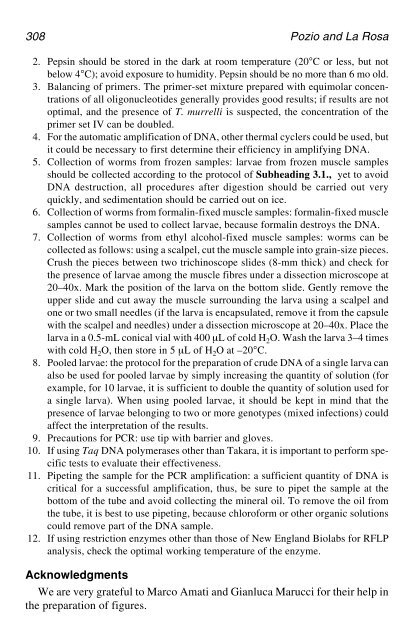PCR Detection of Microbial Pathogens PCR Detection of Microbial ...
PCR Detection of Microbial Pathogens PCR Detection of Microbial ...
PCR Detection of Microbial Pathogens PCR Detection of Microbial ...
You also want an ePaper? Increase the reach of your titles
YUMPU automatically turns print PDFs into web optimized ePapers that Google loves.
308 Pozio and La Rosa<br />
2. Pepsin should be stored in the dark at room temperature (20°C or less, but not<br />
below 4°C); avoid exposure to humidity. Pepsin should be no more than 6 mo old.<br />
3. Balancing <strong>of</strong> primers. The primer-set mixture prepared with equimolar concentrations<br />
<strong>of</strong> all oligonucleotides generally provides good results; if results are not<br />
optimal, and the presence <strong>of</strong> T. murrelli is suspected, the concentration <strong>of</strong> the<br />
primer set IV can be doubled.<br />
4. For the automatic amplification <strong>of</strong> DNA, other thermal cyclers could be used, but<br />
it could be necessary to first determine their efficiency in amplifying DNA.<br />
5. Collection <strong>of</strong> worms from frozen samples: larvae from frozen muscle samples<br />
should be collected according to the protocol <strong>of</strong> Subheading 3.1., yet to avoid<br />
DNA destruction, all procedures after digestion should be carried out very<br />
quickly, and sedimentation should be carried out on ice.<br />
6. Collection <strong>of</strong> worms from formalin-fixed muscle samples: formalin-fixed muscle<br />
samples cannot be used to collect larvae, because formalin destroys the DNA.<br />
7. Collection <strong>of</strong> worms from ethyl alcohol-fixed muscle samples: worms can be<br />
collected as follows: using a scalpel, cut the muscle sample into grain-size pieces.<br />
Crush the pieces between two trichinoscope slides (8-mm thick) and check for<br />
the presence <strong>of</strong> larvae among the muscle fibres under a dissection microscope at<br />
20–40x. Mark the position <strong>of</strong> the larva on the bottom slide. Gently remove the<br />
upper slide and cut away the muscle surrounding the larva using a scalpel and<br />
one or two small needles (if the larva is encapsulated, remove it from the capsule<br />
with the scalpel and needles) under a dissection microscope at 20–40x. Place the<br />
larva in a 0.5-mL conical vial with 400 µL <strong>of</strong> cold H 2O. Wash the larva 3–4 times<br />
with cold H 2O, then store in 5 µL <strong>of</strong> H 2O at –20°C.<br />
8. Pooled larvae: the protocol for the preparation <strong>of</strong> crude DNA <strong>of</strong> a single larva can<br />
also be used for pooled larvae by simply increasing the quantity <strong>of</strong> solution (for<br />
example, for 10 larvae, it is sufficient to double the quantity <strong>of</strong> solution used for<br />
a single larva). When using pooled larvae, it should be kept in mind that the<br />
presence <strong>of</strong> larvae belonging to two or more genotypes (mixed infections) could<br />
affect the interpretation <strong>of</strong> the results.<br />
9. Precautions for <strong>PCR</strong>: use tip with barrier and gloves.<br />
10. If using Taq DNA polymerases other than Takara, it is important to perform specific<br />
tests to evaluate their effectiveness.<br />
11. Pipeting the sample for the <strong>PCR</strong> amplification: a sufficient quantity <strong>of</strong> DNA is<br />
critical for a successful amplification, thus, be sure to pipet the sample at the<br />
bottom <strong>of</strong> the tube and avoid collecting the mineral oil. To remove the oil from<br />
the tube, it is best to use pipeting, because chlor<strong>of</strong>orm or other organic solutions<br />
could remove part <strong>of</strong> the DNA sample.<br />
12. If using restriction enzymes other than those <strong>of</strong> New England Biolabs for RFLP<br />
analysis, check the optimal working temperature <strong>of</strong> the enzyme.<br />
Acknowledgments<br />
We are very grateful to Marco Amati and Gianluca Marucci for their help in<br />
the preparation <strong>of</strong> figures.






